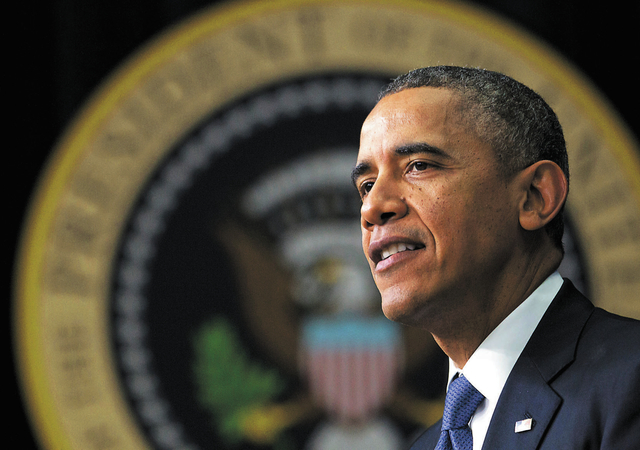Still puzzled over the Affordable Care Act? You’ve got some company

If you’re still scratching your head over the Affordable Care Act, you’re not alone.
What will co-pays look like? Will the law help cut health care prices and spending? Who is eligible for a tax credit to buy a plan? And how many people have actually, really signed up for coverage through federal and state exchanges?
Beats us.
But we know if we have questions, you do, too. That’s why we’re launching Obamacare Explained, a weekly Sunday feature that will help Las Vegans sort out tax quibbles, understand coverage mandates and figure out how the law applies to their specific case. We may even print the occasional harangue or hosanna. And we’ll all learn together about this biggest, newest law of the land.
Up first is a cry for help from Nevada’s southernmost point.
After we wrote in November about how the Affordable Care Act is affecting rural areas, we got an email from Jim Maniaci, secretary of the Laughlin Economic Development Corp., lamenting how the law amplifies provider shortages in his area.
Maniaci said Laughlin’s problem is that “99.999 percent of services” are across the state line. Take hospitals: Laughlin doesn’t have one, so locals typically head over to Valley View Medical Center in Fort Mohave, Ariz., or Western Arizona Regional Medical Center in Bullhead City.
But, as we learned when we researched what is happening in Elko and other parts of Northern Nevada, provider networks on the Silver State Health Insurance Exchange don’t include out-of-state hospitals. So, rather than driving two miles across the Colorado River and back, or 10 miles down Arizona Highway 95, Laughlin residents with exchange-based plans are looking at 170 miles round trip to Henderson or Las Vegas for hospital care.
It doesn’t help that Laughlin, like many Nevada cities big and small, already has a shortage of primary-care doctors that is unrelated to exchange-based networks.
Of the 122 doctors within 15 miles of Laughlin who are available on the exchange, 41 practice internal medicine, and just four specialize in pediatrics. The rest are specialists, but you typically can’t see a specialist unless you get some face time with a primary-care doc first, Maniaci pointed out.
Nor does Laughlin have any pharmacies. That means driving at least to Boulder City to pick up meds.
So, Laughlin officials are taking matters into their own hands. They are circulating a survey among big drugstore companies in an effort to draw a branch for the town of 9,000. They also are looking for ways to attract more family doctors, but it’s tough to compete for providers with Las Vegas “and all of its attractions,” Maniaci said.
Sure, it’s never been easy to find care in Nevada’s hinterlands, but the Affordable Care Act just highlights the issue, Maniaci said.
“It all boils down to the lack of readily accessible providers.”
■ Dave Bax asks (try saying that five times): Can you sign up for coverage anytime outside of open enrollment, or do you have to have a triggering event?
This is essentially a question about whether you can wait until after you’re sick to get health insurance.
The Affordable Care Act prohibits insurers on and off the exchange from denying coverage or charging higher premiums based on pre-existing conditions. It’s called guaranteed issue.
But, if you think you can break a leg, buy a plan in the ER and immediately be covered, think again. After extended enrollment ends March 31, you will be able to enroll only from Oct. 15 to Dec. 7 every year.
The exception? If you have a “qualifying life event,” fed-speak for a change in your household’s dependent or employment status. If you get married or divorced, get pregnant or have a baby, move to a new state, lose your job or lose your job-sponsored coverage, you can buy outside the enrollment period. Even then, you will have a waiting period of 15 to 45 days, depending on what time of month you apply.
On some level, guaranteed issue lets you go without coverage until something happens. Still, do some math before you take that chance: If you enroll the day your premature baby is born, for example, you could be on the hook for up to 45 days’ worth of neonatal intensive care at an average of more than $3,000 a day.
■ In response to a recent story on Silver State Health Insurance Exchange enrollment, Gerald Carrick wrote: Keep drinking the Kool-Aid, and remember government lies. No one has insurance that (has) to pay for it because there is no system to pay.
Hey, Gerald, thanks for your concern about our sugar intake. But we stick exclusively with water and tea, so don’t sweat it.
As to the rest, you might be confusing the Nevada exchange with the federal version.
It’s true that Henry Chao, chief information officer for the Centers for Medicare and Medicaid Services, told Congress in November that as much as 40 percent of the federal exchange’s website hadn’t been built, including systems to let consumers pay premiums.
It was unclear by New Year’s whether any consumers in the federal marketplace had been able to pay for coverage at all. And if they haven’t paid, they are not technically enrolled.
Nevada is not part of the federal exchange, though, so this isn’t an issue here.
Nevada Health Link processed its first payment on Oct. 1, the day it opened for business, and had processed more than 6,000 additional premium payments through late December.
Have a question or comment you’d like to run by Obamacare Explained? Email jrobison@reviewjournal.com or tweet @J_Robison1.












